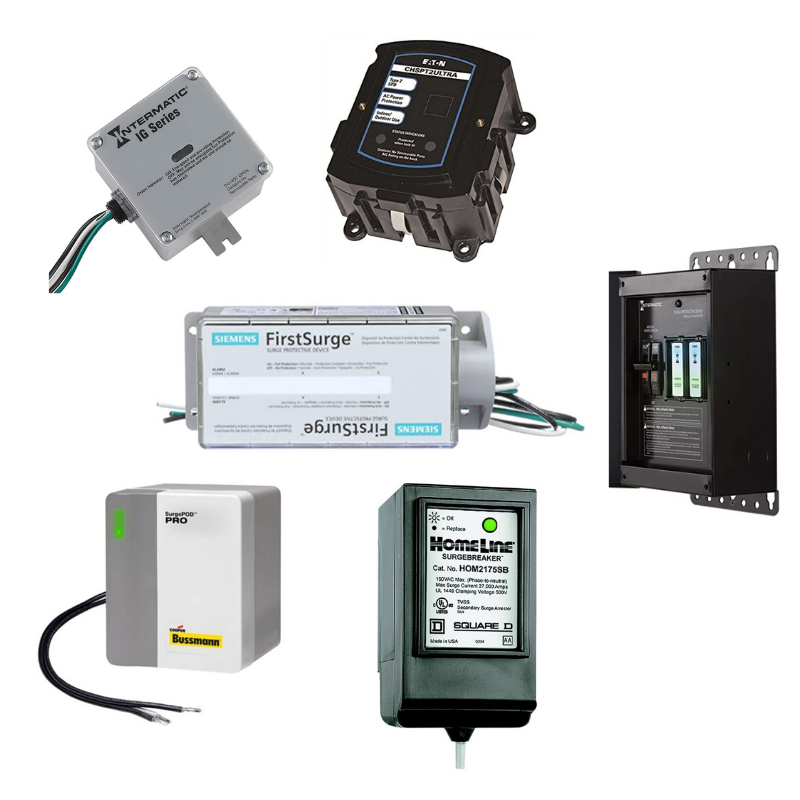
A power surge hits like a hurricane. Unlike most weather systems, a power surge is unpredictable.
Without a doubt, the damage could potentially be thousands of dollars. Subsequently, without a whole house surge protector, all the electronics and electrical appliances could be destroyed in a matter of seconds without warning!
The inconvenience of not using your appliances is depressing if you think about it. You may not be able to do the cooking, laundry, lighting may be affected in addition to your other home electronics – the TV, laptop, computer, music system, etc
Quick Navigation in this Resource
- 1 Quick Comparison Table
- 2 What Causes Power Surges?
- 3 Whole House Surge Protector Buyer’s Guide
- 4 Top Whole House Surge Protector Reviews
- 5 Step-by-Step Installation Guide
- 6 Frequently Asked Questions
- 6.1 Does a whole house surge protector work?
- 6.2 What is the best whole house surge protector?
- 6.3 What should I look for in a whole house surge protector?
- 6.4 How does a whole house surge protector work?
- 6.5 What types of whole house surge protectors are available?
- 6.6 What is the installation process like?
- 6.7 Can whole house surge protectors handle lightning strikes?
- 6.8 How much do whole house surge protectors cost?
- 6.9 What are the limitations of whole house surge protectors?
- 7 The Final Verdict Regarding Whole Home Surge Protector
Quick Comparison Table
| Product | Image | Key Features | Price |
|---|---|---|---|
| Intermatic Smart Guard IG2240-IMSK Whole Home Surge Protector Manufacturer: Intermatic | Surge Rating: 10kA | 🔲 Six Modes of protection 🔲 $50,000 connected equipment warranty for 10 years on appliances and electronics 🔲 Replaceable IModules | ⭐️⭐️⭐️⭐️⭐️ |
| Siemens QSA2020SPD Whole House Surge Protection Manufacturer: Siemens | Surge Rating: 140kA / 10kA | 🔳 House wiring system warranty amount $20,000 🔳 2 yrs Warranty Period | ⭐️⭐️ |
| Square D QO2175SB SurgeBreaker Protective Device Manufacturer: Schneider Electric | Surge Current Rating per Phase 22.5kA | 🔲 Three modes of protection 🔲 Individually fused MOVs 🔲 3 years warranty | ⭐️ |
| Siemens FS100 Protection Device Whole House Surge Protector Manufacturer: Siemens | Surge Rating: 100kA - Rated for 120/240 split phase panels up to 400A  | 🔳 Ground Reference Monitoring (GRM) 🔳 Installs onto any brand load center 🔳 Type 4 rated outdoor enclosure 🔳 10 year product and connected equipment warranty 🔳 3 Stage Commercial Grade Notification that includes an audible alarm | ⭐️⭐️⭐️⭐️ |
| Intermatic IG1240RC3 Whole Home Type-1 or 2 Surge Protection Device Manufacturer: Intermatic | Surge Rating: 20kA | 🔲 Six modes of surge protection 🔲 5-year product warranty 🔲 $10,000 connected equipment warranty on appliances and electronics | ⭐️⭐️⭐️ |
| Square D HOM2175SB Homeline SurgeBreaker Surge Protective Device Manufacturer: Schneider Electric |  | 🔳 Installs as easily as a circuit breaker 🔳 UL 1449 3rd Edition Listed Type 2 Surge Protective Device | ⭐️ |
| EATON CHSPT2ULTRA Ultimate Surge Protection Manufacturer: Eaton | Surge Rating: 108kA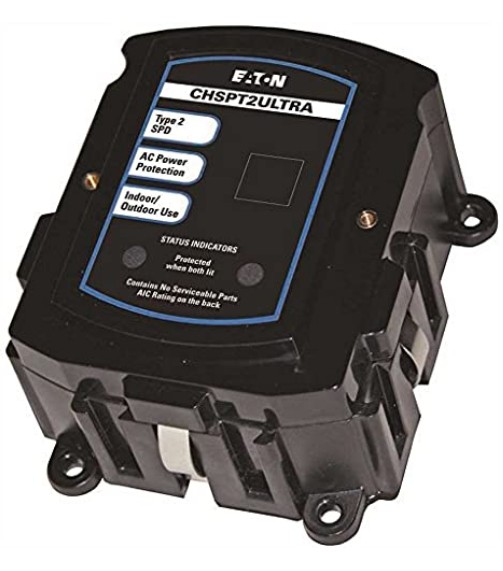 | 🔲 4 modes of protection. 600V L-N, 1000V L-L, 800V N-G, 600V L-G | ⭐️⭐️ |
| Siemens FS140 Whole House Surge Protection Manufacturer: Siemens | Surge Rating: 140kA | 🔳 Ground Reference Monitoring (GRM) 🔳 Installs onto any brand load center 🔳 Type 4 rated outdoor enclosure 🔳 10 year product and connected equipment warranty 🔳 3 Stage Commercial Grade Notification that includes an audible alarm | ⭐️⭐️⭐️⭐️ |
| Leviton 51120-1 Surge Panel Protector Manufacturer: Leviton | Surge Rating: 50kA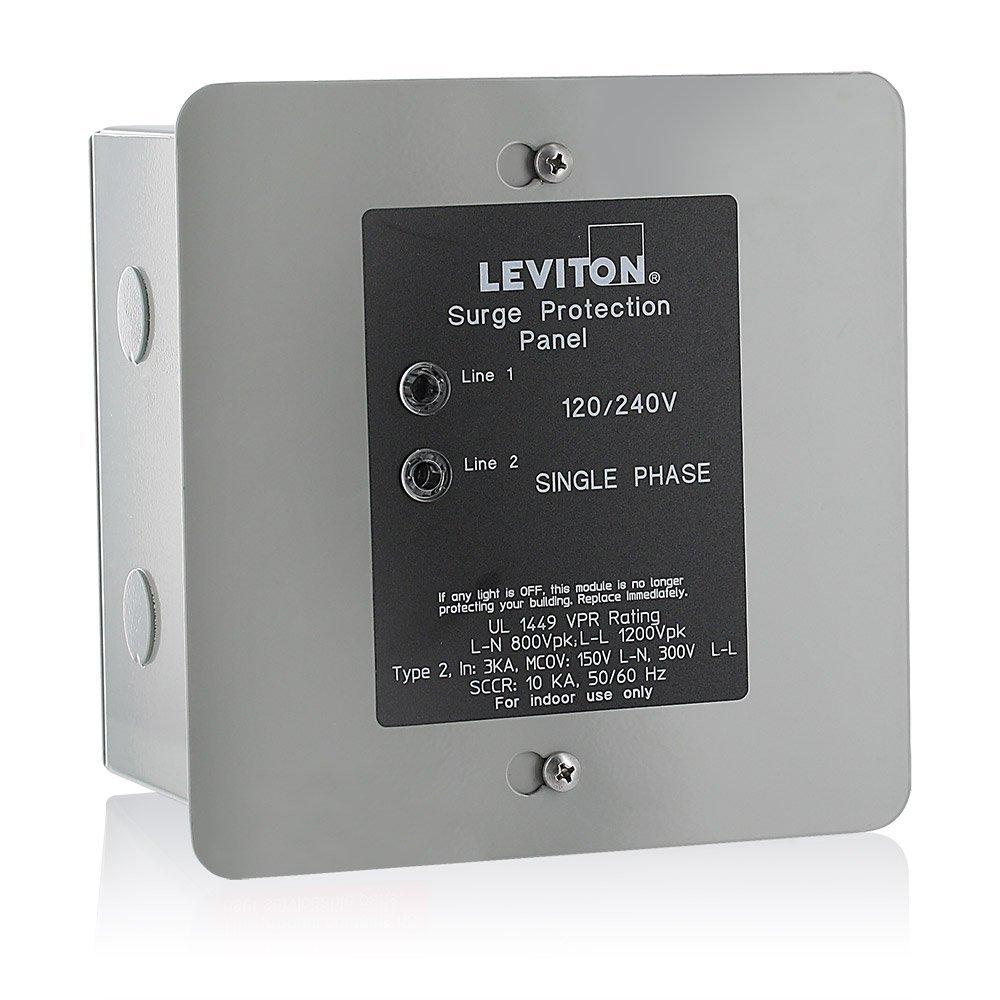 | 🔲 Connected Equipment Coverage: Up to $25,000 🔲 Warranty: 5-Year Limited | ⭐️⭐️⭐️⭐️ |
| Eaton CH230SURCS Circuit Breaker and Surge Protective Device Manufacturer: Eaton |  | 🔳 Combination of circuit protection and surge protection provides flexibility and space savings in the load center 🔳 Direct connection to the bus-bar provides superior protection and easy installation for new construction or renovation | ⭐️⭐️ |
| Bussmann RB-SPP-240PN Cooper Protector Manufacturer: Eaton | Surge Rating: 40kA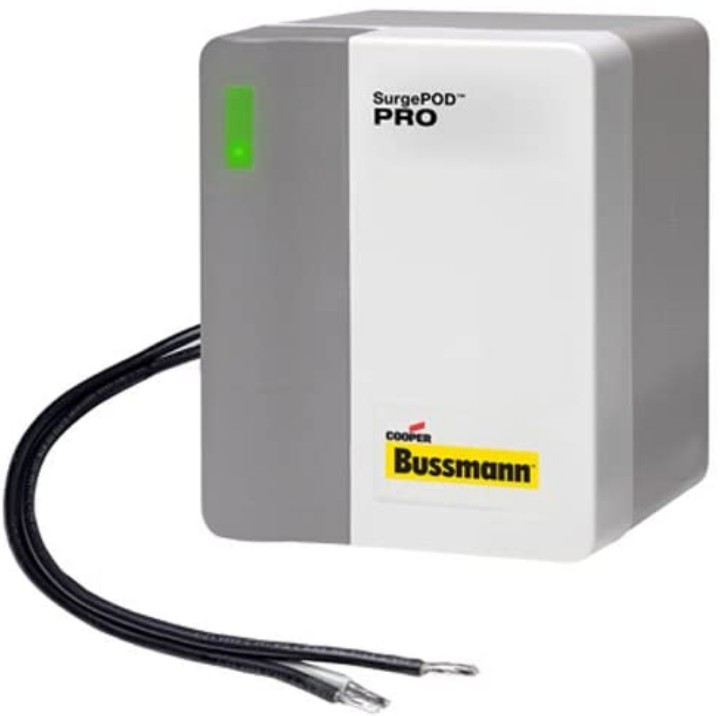 | 🔲 Type 1 UL® 1449 4thEdition Listed SurgeProtective Devices 🔲 2 years product warranty 🔲 Compact UV resistant NEMA 4X enclosure for indoor or outdoor installation 🔲 Thermal disconnect technology eliminates the need for additional fusing 🔲 Response time < 25nS | ⭐️⭐️ |
What Does a Whole House Surge Protector Do?
A power surge is a spike in voltage that lasts for a few milliseconds and may range from hundred to thousands of volts!
With this in mind, installation of the best whole house surge protector is a sure way of preventing this destructive force.
A whole house surge protector installed by an electrician at the main electrical panel offers the first and overall defense against power surges to the entire home.
I have come across a variety of solutions in the market that are very affordable and which I will be recommending later to you.
Further, the best whole house surge protector ensures you do not get unavoidable disruptions at home.
It is better to have one than wait to replace costly electronics and home appliances after they fail. As the old saying goes, prevention is better than cure!
Check out the full benefits and drawbacks of a whole house surge protector.
Undoubtedly, surge protected extensions are not as effective as a whole house surge protector!
What Causes Power Surges?
Power surges at home are as a result of internal and external activities. The most popular known external activity is lightning strikes.
However, this is not the only cause of surges. For instance, power outages and transition of large power equipment along the supply lines can cause this undesirable phenomenon.
Internally, appliances with large motors, for example air conditioners or pool pumps can cause surges in your electrical wiring.
In the event of a power surge, your electronics and appliances may not be damaged instantly.
However, it should be noted that sometimes repeated small or large voltage spikes may lead to reduced useful life.
“I never fully believed that surges were a real issue but after replacing the dishwasher and microwave plus fixing the subzero and hvac….I am a believer.”
Anonymous customer
Whole House Surge Protector Buyer’s Guide
Although no one really needs to confirm that their surge protectors work or not ( I prefer there will be no surges at all), the reliability of your device to guard your home is very important to everyone spending their money.
To avoid a false security that there is surge protection, make use of the guidelines below;
Modes of Protection
Line to Neutral (L-N), Neutral to Ground (N-G), Line to Ground (L-G) on both incoming lines and Line to Line (L-L)
Ease of installation
A great surge protector should not be difficult to fix. It should take less time and fit in easily in well in a standard electrical panel.
If you are familiar with electrical panels, you can fix. However, if you are not, I strongly recommended that you engage an electrician for safety.
Remember that all surge protectors must be installed in accordance to NFPA 70 and NEC 2020.
Surge Protection Rating
The most important to watch here is the maximum current the protection device that you are buying can handle.
Take great care here because the maximum current is the ceiling beyond which the SPD will break down, overheat or even catch fire.
It is advisable by IEEE to have a minimum of 10kA. The short circuit voltage is equally crucial and will be 15% higher than the expected normal operating voltage.
It is likely that the higher the maximum current rating, the more the MOVs used and consequently the more pricier the surge protection device.
Joule Rating
When choosing a surge protector, consider the surge protection rating, which is measured in joules. The higher the joule rating, the more energy the protector can absorb, offering better protection.
Also, look at the clamping voltage—lower is better because it means the device will divert the surge quicker.
Response Time
Surge protectors don’t act instantaneously; they have a response time, usually measured in nanoseconds.
The faster the response time, the quicker the protection kicks in following the detection of a surge.
Material Quality
Equally important is the material used to construct the surge protector. It must be able to absorb a lot of energy without failure and overheating.
Inside they use semiconductor materials while the housing is made of high insulation materials like polymers.
Circuit Breaker
Moreover, a compatible circuit breaker that will work with your surge protector is very crucial for your whole house surge protector device to work effectively.
See how to tell if a surge protector or circuit breaker is bad.
Tech Support
This makes a good product even greater. It is not unusual while working with tech gadgets that you find yourself stuck.
When the manufacturer offers after sales service or support, it gives an added peace of mind. Its a good feeling when you have back up in case something is not going as expected.
Cable Lengths
The length of the cables can limit how and where you install your surge protector. Hence, check your electrical panel and determine the exact position you will install your surge protector.
Thereafter identify the length of cables required and factor that in your purchase. Ideally, you do not want to be disappointed after buying or compromise the quality of your installation.
Type of the Surge Protection
Type 1 and 2 surge protectors are installed directly under the incoming breaker.
We use Type 1 when there is a lightning bolt installed on the building roof. However, when there is none, we use Type 2.
On the other hand, Type 3 is installed to supplement Type 2 surge protectors and is done in parallel with the sensitive loads. ( Television, Computers, Servers, printers and other electronics)
Table Summarizing the Types of Surge Protectors and Their Characteristics
| Type | Installation Location | Protection Level |
|---|---|---|
| Type 1 | Service entrance | High – handles large surges, typically from external sources |
| Type 2 | Main electrical panel | Medium – protects against surges from external and internal sources |
| Type 3 | Point-of-use | Low – additional protection directly at the appliance |
Surge Life
This is the number of times that an SPD can pass harmful power surges through them without becoming comprised.
Adherence to Standards
Since this is one of the product that acts like an insurance policy, consciousness to quality should not be snubbed.
One of the ways to be assured that the SPD meets high standards is through approval by reputable bodies such as UL.
UL 1449, third edition, is a great benchmark.
Top Whole House Surge Protector Reviews
Now here is a detailed review of the best whole house surge protector.
#1. Intermatic Smart Guard IG2240-IMSK Whole Home Surge Protector

- This power surge protector has 6 modes of protection
- Additionally, the device is very reliable – it uses thermally protected MOV (TPMOV) technology
- It offers protection for your electronics and home appliances for 10 years
- It has 3 IModules with LED status that can be replaced independently in case they fail with no need to replace. As a result this makes the surge protector reusable with only the affected modules requiring replacement. We can say confidently that customers really like this feature. Furthermore the modules are easy to slide in and you do not need to rewire the device again into the electrical panel.
#2. Siemens Whole House Surge Protector Reviews | FS140

- This is a premium product. Siemens gives a guarantee that it will work and protect your equipment / appliances for ten years.
- There is an audible alarm that warns you in case of failure. When the alarm goes off it means it is protecting nothing.
- Siemens FirstSurge FS140 Whole House Surge Protection Device is rated for 140,000 Amps
- UL 1449 listed, Type 2 surge protective device (SPD)
- It also provides a 900-volt protection for line-to-line surges (L-L), and it provides a 600-volt protection for line-to-neutral (L-N), line-to-ground (L-G), and neutral-to-ground (N-G) surges according to UL 1449 3rd Edition, Voltage Protection Ratings.
- Voltage clamp-down response time of less than 1 nanosecond, which is extremely fast and needed for protection of your sensitive electronic equipment
- NEMA 4X indoor and outdoor rated enclosure
#3. Eaton whole house surge protector | CHSPT2ULTRA
Eaton whole house surge protector installation is very straight forward.

- 4 modes of protection
- The maximum surge current capacity is 108kA
- UL certified
- A double pole circuit breaker rated at 50A is required
#4. Square D Whole House Surge Protector | QO2175SB
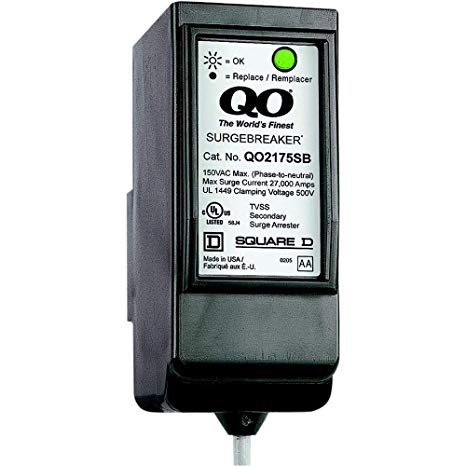
- UL 1449 listed, Type 2 Surge Protective Device
- Since it is directly connected to the bus, it offers a very short response time to surges.
- Also it provides Peak Surge Current Rating Per Phase of 30kA, Surge Current Rating per Phase 22.5kA, Short Circuit Current Rating 22kA
- Modes of Protection 3. L-N, L-G, L-L.
- Fusing Individually fused MOVs
- Very easy to install
- Fits in QO or NQ panel boards. If you have a Square D Homeline panel, then you shoud buy the HOM2175SB SPD instead of the QO2175SB. It requires 2 adjascent spaces.
#5. Leviton 51120-1 Panel Protector, 120/240-Volt

- 4 Modes of Protection. L-N, L-G, L-L.
- Visual indicators are helpful for diagnosis and getting to know the status of the device.
- If device is within 5 years of warranty and a surge hits and destroys this unit, Leviton will replace it. Further, you can get compensated for up to $25,000 for connected equipment.
- 50kA Max Surge Current Rating, Short Circuit Current Rating: 10kA.
- Moreover, it is UL 1449 4th Edition Type 2 Surge Protective Device.
- NEMA 1 Enclosure.
Step-by-Step Installation Guide
Installing a whole-house surge protector involves several key steps and requires basic electrical knowledge. If you’re not comfortable with electrical work, it’s advisable to hire a professional.
However, for those interested in the DIY approach, here’s what you need to know:
- Turn Off the Main Power: Safety first! Ensure all power is off at the main breaker.
- Choose the Right Location: Typically, the surge protector is installed at the main electrical panel.
- Mount the Surge Protector: Secure the device to the wall or panel as directed by the manufacturer.
- Make the Electrical Connections: Connect the surge protector’s wires to the appropriate breaker and the ground bar in your panel.
Tools and Precautions
The installation of a whole-house surge protector requires specific tools and safety precautions to ensure everything goes smoothly and safely.
Necessary Tools and Safety Gear
| Tool/Gear | Purpose |
|---|---|
| Screwdrivers | For opening the panel and securing connections |
| Wire Strippers | To prepare wires for connection |
| Safety Gloves | To protect hands from sharp edges and electrical components |
| Flashlight | To enhance visibility in dim areas |
Frequently Asked Questions
Does a whole house surge protector work?
Of course they do. Given the above, there are a lot of unseen and unpredictable voltage spikes that could do a lot of damage if a whole house surge protector is missing in your home.
What is the best whole house surge protector?
Our No 1 Choice is: Intermatic Smart Guard IG2240
What should I look for in a whole house surge protector?
- Key features to consider include a high surge current rating, low clamping voltage, and certifications like UL 1449 to ensure safety and effectiveness. Additionally, features like indicator lights and alarms can provide visual cues about the protector’s status. See further details here.
How does a whole house surge protector work?
- These devices are installed at your service panel and protect all your electrical appliances by blocking or redirecting excess voltage to the ground, effectively preventing damage during surges. We have a detailed article on how a whole home surge protector work.
What types of whole house surge protectors are available?
- There are Type 1, Type 2, and Type 3 SPDs, with Type 1 being used at the service entrance and Type 2 at the main electrical panel. Type 3 is used close to sensitive devices and offers the least surge protection.
What is the installation process like?
- Installation typically requires an electrician, as it involves wiring the device to your home’s electrical panel. Some models offer easy installation features, but professional installation is recommended to ensure safety and validity of warranties. See step by step guide for DIY installation.
Can whole house surge protectors handle lightning strikes?
- While they provide significant protection against surges, no surge protector can completely safeguard against a direct lightning strike. However, they are very effective against surges caused by indirect lightning strikes and other sources.
How much do whole house surge protectors cost?
- The cost can vary widely based on features and brand. Expect to pay between $100 and $400 for the surge protector itself, with additional costs for installation by a qualified electrician.
What are the limitations of whole house surge protectors?
- While highly effective, they do have limitations. They need to be replaced after a significant surge or at the end of their life span, and they cannot protect against direct, powerful lightning strikes
The Final Verdict Regarding Whole Home Surge Protector
In most of the home owners insurance policies you will find that a whole house surge protector is a requirement.
Of course there are people who act after an incidence – they will only install a whole house surge protector if they somehow suffered due to undesirable transient voltage spikes.
Well, you do not have to wait. Prevent it before it happens.
To illustrate this further, you can relate the best whole house surge protector to the oxygen masks in an airplane. Nobody wants or plans to use them.
But can you imagine boarding a plane that didn’t have one?
In other words, your electronics and appliances need some love too. Show them you care today!